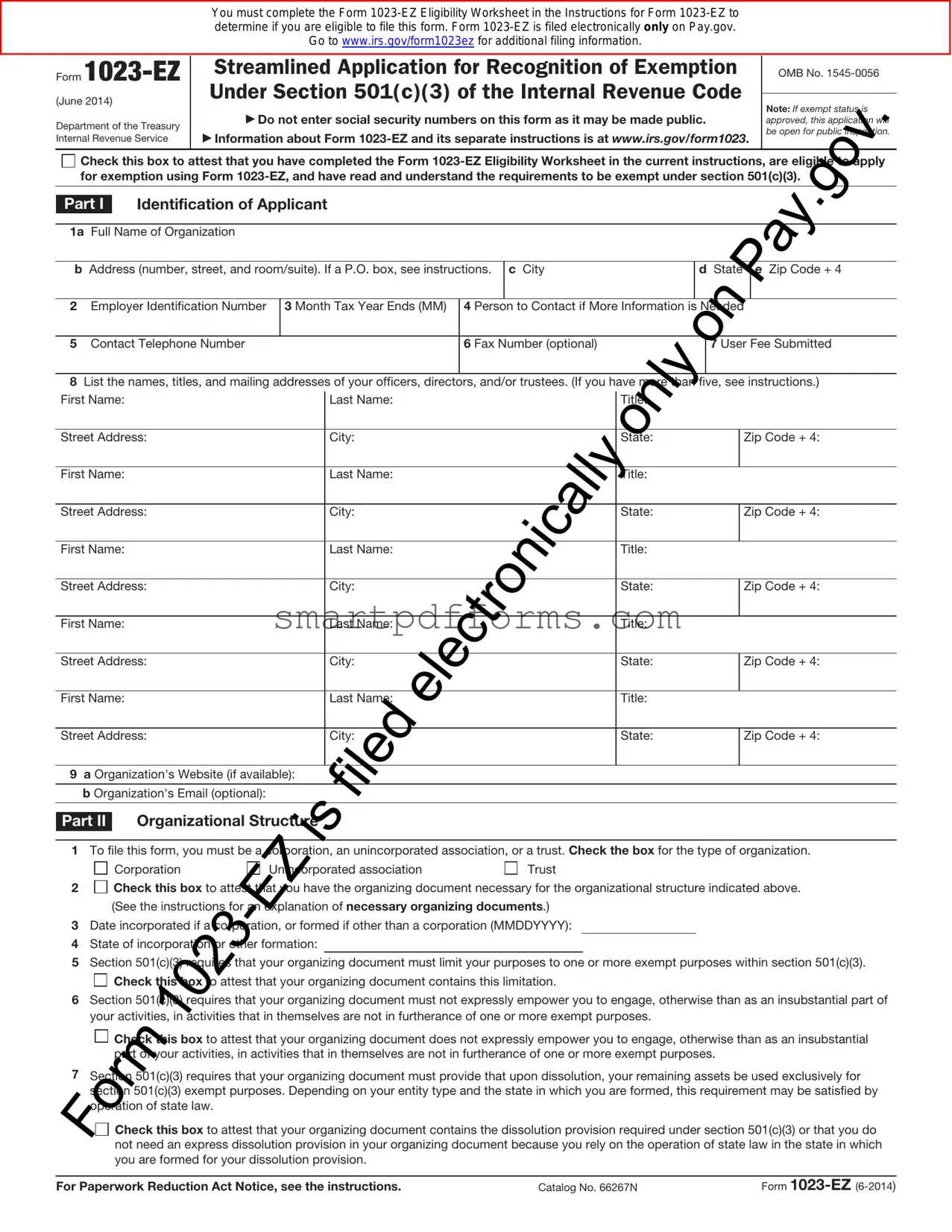You must complete the Form 1023-EZ Eligibility Worksheet in the Instructions for Form 1023-EZ to determine if you are eligible to file this form. Form 1023-EZ is filed electronically only on Pay.gov.
Go to www.irs.gov/form1023ez for additional filing information.
Form 1023-EZ
(June 2014)
Department of the Treasury Internal Revenue Service
Streamlined Application for Recognition of Exemption Under Section 501(c)(3) of the Internal Revenue Code
Do not enter social security numbers on this form as it may be made public.
Information about Form 1023-EZ and its separate instructions is at www.irs.gov/form1023.
OMB No. 1545-0056
Note: If exempt status is approved, this application will be open for public inspection.
Check this box to attest that you have completed the Form 1023-EZ Eligibility Worksheet in the current instructions, are eligible to apply for exemption using Form 1023-EZ, and have read and understand the requirements to be exempt under section 501(c)(3).
Part I Identification of Applicant
1a Full Name of Organization
bAddress (number, street, and room/suite). If a P.O. box, see instructions.
2 |
Employer Identification Number |
3 Month Tax Year Ends (MM) |
4 Person to Contact if More Information is Needed |
|
|
|
|
|
5 |
Contact Telephone Number |
|
6 Fax Number (optional) |
7 User Fee Submitted |
|
|
|
|
|
8List the names, titles, and mailing addresses of your officers, directors, and/or trustees. (If you have more than five, see instructions.)
First Name: |
Last Name: |
Title: |
|
|
|
|
|
Street Address: |
City: |
State: |
Zip Code + 4: |
|
|
|
|
First Name: |
Last Name: |
Title: |
|
|
|
|
|
Street Address: |
City: |
State: |
Zip Code + 4: |
|
|
|
|
First Name: |
Last Name: |
Title: |
|
|
|
|
|
Street Address: |
City: |
State: |
Zip Code + 4: |
|
|
|
|
First Name: |
Last Name: |
Title: |
|
|
|
|
|
Street Address: |
City: |
State: |
Zip Code + 4: |
|
|
|
|
First Name: |
Last Nam : |
Title: |
|
|
|
|
|
Street Address: |
City: |
State: |
Zip Code + 4: |
|
|
|
|
9 a Organization's Website (if available): |
|
|
|
|
|
|
|
b Organization's Email (optional): |
|
|
|
|
|
|
|
Part II Organizational Structure
1To file this form, you must be a corporation, an unincorporated association, or a trust. Check the box for the type of organization.
|
Corporation |
Unincorporated association |
Trust |
2 |
Check this box to attest that you have the organizing document necessary for the organizational structure indicated above. |
(See the instructions for an explanation of necessary organizing documents.)
3Date incorporated if a corporation, or formed if other than a corporation (MMDDYYYY):
4State of incorporation or other formation:
5Section 501(c)(3) requires that your organizing document must limit your purposes to one or more exempt purposes within section 501(c)(3).
Check this box to attest that your organizing document contains this limitation.
6Section 50 (c)(3) requires that your organizing document must not expressly empower you to engage, otherwise than as an insubstantial part of your activities, in activities that in themselves are not in furtherance of one or more exempt purposes.

 Check this box to attest that your organizing document does not expressly empower you to engage, otherwise than as an insubstantial part of your activities, in activities that in themselves are not in furtherance of one or more exempt purposes.
Check this box to attest that your organizing document does not expressly empower you to engage, otherwise than as an insubstantial part of your activities, in activities that in themselves are not in furtherance of one or more exempt purposes.
7Section 501(c)(3) requires that your organizing document must provide that upon dissolution, your remaining assets be used exclusively for secti n 501(c)(3) exempt purposes. Depending on your entity type and the state in which you are formed, this requirement may be satisfied by
peration of state law.
Check this box to attest that your organizing document contains the dissolution provision required under section 501(c)(3) or that you do not need an express dissolution provision in your organizing document because you rely on the operation of state law in the state in which you are formed for your dissolution provision.
For Paperwork Reduction Act Notice, see the instructions. |
Catalog No. 66267N |
Form 1023-EZ (6-2014) |

You must complete the Form 1023-EZ Eligibility Worksheet in the Instructions for Form 1023-EZ to determine if you are eligible to file this form. Form 1023-EZ is filed electronically only on Pay.gov.
Go to www.irs.gov/form1023ez for additional filing information.
Form 1023-EZ (6-2014) |
Page 2 |
Part III Your Specific Activities
1Enter the appropriate 3-character NTEE Code that best describes your activities (See the instructions):
2 To qualify for exemption as a section 501(c)(3) organization, you must be organized and operated exclusively to further one or more f the following purposes. By checking the box or boxes below, you attest that you are organized and operated exclusively to further the purp ses indicated. Check all that apply.
Charitable |
Religious |
Educational |
Scientific |
Literary |
Testing for public safety |
To foster national or international amateur sports competition |
Prevention of cruelty to children or animals |
3To qualify for exemption as a section 501(c)(3) organization, you must:
•Refrain from supporting or opposing candidates in political campaigns in any way.
•Ensure that your net earnings do not inure in whole or in part to the benefit of private shareholders or individuals (that is, board members, officers, key management employees, or other insiders).
•Not further non-exempt purposes (such as purposes that benefit private interests) more than insubstantially.
•Not be organized or operated for the primary purpose of conducting a trade or business that is not related to y ur exempt purpose(s).
• Not devote more than an insubstantial part of your activities attempting to influence legislation or, if ou made a section 501(h) election, not normally make expenditures in excess of expenditure limitations outlined in section 501(h).
•Not provide commercial-type insurance as a substantial part of your activities.
Check this box to attest that you have not conducted and will not conduct activities that violate these prohibitions and restrictions.
4 |
Do you or will you attempt to influence legislation? |
|
Yes |
|
No |
|
(If yes, consider filing Form 5768. See the instructions for more details.) |
|
|
|
|
5 |
Do you or will you pay compensation to any of your officers, directors, or trustees? |
|
Yes |
|
No |
|
|
|
(Refer to the instructions for a definition of compensation.) |
|
|
|
|
6 |
Do you or will you donate funds to or pay expenses for individual(s)? |
|
Yes |
|
No |
|
|
7 |
Do you or will you conduct activities or provide grants or other assistance to individu l(s) or organization(s) outside the |
|
|
|
|
8 |
United States? |
|
Yes |
|
No |
Do you or will you engage in financial transactions (for example, loans, payme ts, rents, etc.) with any of your officers, |
|
|
|
|
|
directors, or trustees, or any entities they own or control? |
|
Yes |
|
No |
9 |
Do you or will you have unrelated business gross income of $1,000 or m e during a tax year? |
|
Yes |
|
No |
|
|
10 |
Do you or will you operate bingo or other gaming activities? |
|
Yes |
|
No |
|
|
11 |
Do you or will you provide disaster relief? |
|
Yes |
|
No |
Part IV is designed to classify you as an organization thatelectronicallyis either private foundation or a public charity. Public charity status is a more favorable tax status than private foundation status.
status is a more favorable tax status than private foundation status.
Part IV Foundation Classification
1 If you qualify for public charity status, check the appropriate box (1a – 1c below) and skip to Part V below.
Check this box to attest that you normally r c ive at least one-third of your support from public sources or you normally receive at least 10 percent of your support from public sourc s and you have other characteristics of a publicly supported organization. Sections 509(a)(1) and 170(b)(1)(A)(vi).
Check this box to attest that you normally receive more than one-third of your support from a combination of gifts, grants, contributions, membership fees, and gross rece pts (from permitted sources) from activities related to your exempt functions and normally receive not more than one-third of your support from nve tment income and unrelated business taxable income. Section 509(a)(2).
c |
Check this box to attest that you are operated for the benefit of a college or university that is owned or operated by a governmental unit. |
|
Sections 509(a)(1) and 170(b)(1)(A)(iv). |
2If you are not described in items 1a – 1c above, you are a private foundation. As a private foundation, you are required by section 508(e) to have specific provisions in your organizing document, unless you rely on the operation of state law in the state in which you were formed to meet these requirements. These specific provisions require that you operate to avoid liability for private foundation excise taxes under sections 4941-4945.
Check this box to attest that your organizing document contains the provisions required by section 508(e) or that your organizing document does not need to include the provisions required by section 508(e) because you rely on the operation of state law in your particular state to meet the requirements of section 508(e). (See the instructions for explanation of the section 508(e) requirements.)
Form 1023-EZ (6-2014)
You must complete the Form 1023-EZ Eligibility Worksheet in the Instructions for Form 1023-EZ to determine if you are eligible to file this form. Form 1023-EZ is filed electronically only on Pay.gov.
Go to www.irs.gov/form1023ez for additional filing information.
Part V Reinstatement After Automatic Revocation
Complete this section only if you are applying for reinstatement of exemption after being automatically revoked for failure to file required annual returns or notices for three consecutive years, and you are applying for reinstatement under section 4 or 7 of Revenue Procedure 2014-11. (Check only one box.)
Check this box if you are seeking retroactive reinstatement under section 4 of Revenue Procedure 2014-11. By checking this box, you attest that you meet the specified requirements of section 4, that your failure to file was not intentional, and that you have put in place procedures to file required returns or notices in the future. (See the instructions for requirements.)
Check this box if you are seeking reinstatement under section 7 of Revenue Procedure 2014-11, effective the date you re filling this application.
I declare under the penalties of perjury that I am authorized to sign this application on behalf of the above organization and that I have examined this application, and to the best of my knowledge it is true, correct, and complete.
(Type name of signer)
F(Signature of Officer, Director, Trustee, or other authorized official)
(Type title or authority of signer)
F(Date)
Form 1023-EZ (6-2014)
Printed on recycled paper





 status is a more favorable tax status than private foundation status.
status is a more favorable tax status than private foundation status.